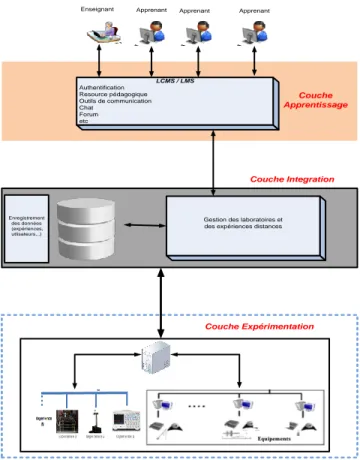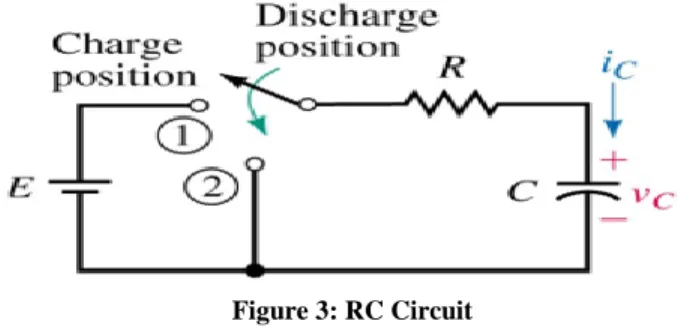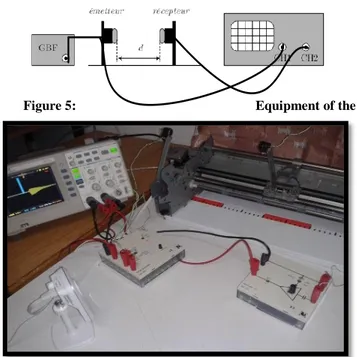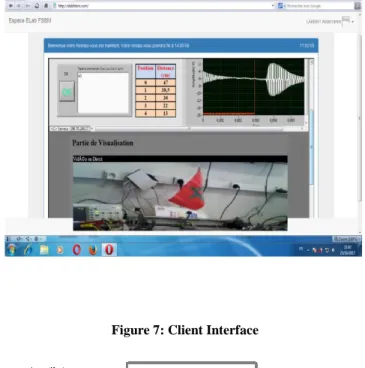Remote Control Laboratory Experiments in
Physics using LabVIEW
Y. Khazri
Physics Department, University Hassan II – Casablanca
Morocco khazri10@gmail.com
H. Toumi
Physics Department, University Hassan II – Casablanca
Morocco toumi.doc@gmail.com
A. Al Sabri
Physics Department, University Hassan II – Casablanca
Morocco a.alsabri2011@gmail.com
M. Moussetad
Physics Department, University Hassan II – Casablanca
Morocco m.moussetad@gmail.com
B. Sabir
Physics Department, University Hassan II – Casablanca
Morocco brahimsabir95@gmail.com
Ahmed Fahli
Physics Department, Hassan I University - Settat,
Morocco fahli@uhp.ac.ma
ABSTRACT
. Remote laboratories are distributed computing environment which allows learners to perform experiments by interacting with real devices, real instruments, and remote mechanisms, through an appropriate platform of telecommunications. The development of remote laboratories is a promising direction for the future of engineering education because they provide means for students to design and conduct experiments without the need for physical laboratory equipment on site. Remotely accessible instruments and experiments enhance the experience of students by providing a remote interface to a physical device. Students perform their exercises at home just as in a real lab so they can apply their experience directly when working on location. Needless to say: remote laboratory are a key to raise the student’s interest and improve self-paced learning. The implementation of a generic remote control interface for existing instruments and the acquisition and visualization of data is one milestone on the road to the future in distance learning. To avoid obstacles on this way, the system architecture should be understandable, modular and easy to extend, so laboratories with different hardware could be integrated in the lab environment.
In this article we describe implementation of the real experiments in physics via remote control and comment on our technical solutions to programming and interfacing problems.
KEYWORDS
Remote laboratories, Engineering Education, Internet, National
The traditional teaching methods for students at schools and universities are obsolete and not effective enough. The students often expect higher level teaching methods in the field of physics, biology, chemistry and electro-engineering, which can help them to perceive real world phenomena in a better way [1].
In engineering education, practical work is an important complement to theoretical courses, students come to the laboratories to conduct experiments and appreciate the discrepancies between their observations and predictions according to the theoretical courses. However, due to several limiting factors in traditional laboratory experiments, students cannot get the necessary experiences. Remote laboratories for instruments control are an important tool for teaching students in physics and of control systems engineering and experimentation with a wide range of feedback devices [2].
Remote laboratories refer to a distributed computing environment used as a distance education platform. It is flexible, allowing the student to perform experiments through interactions with real devices and, real instruments, via remotely operated mechanisms. This type of educational experience is essential in scientific and technical training. Moreover, being able to provide these experiences to students remotely meets real needs of both the students and the universities [14].
The development of remote laboratories is a promising direction for the future of engineering education because they provide means for students to design and conduct experiments without the need for physical laboratories equipment on site.
With remote laboratories, the interactions between the students and the reel instruments are facilitated by an appropriate communications platform which is equipped with a system dedicated to the management of a number of software and hardware interfaces [4]. Remote laboratories allow a practical education to growing numbers of students, despite the material resources and often limited supervision [15]. They can also enable the sharing of handling between several academic institutions nationally or internationally, and to enjoy the various partner’s costly resources which they would not have access.
3 REMOTE LABORATORIES IN PHYSICS
(E-LAB FSBM)
3.1.1.
Architecture
ELAB FSBM is the remote laboratories in physics, which we developed in the Faculty of Sciences Ben M'sik in Casablanca. The Remote laboratories are flexible, distributed environments, which enable a learner to perform real experiments via the web. The learner carries out the experiment and takes measurements online, but he or she can recover the real, rather than simulated, experimental results in order to utilize them. Each participant plays a role during his or her interactions with other laboratories participants, allowing all participants to share in hardware resources and in one another’s expertise [6,7]. A remote laboratory can be built according to the following diagram (Fig 1):
Figure 1: The architecture of E-LAB FSBM
The Interactive Lab Server is the component that is connected directly to the lab equipment and deals with the actual operation of the experiment hardware. It is the administrative interface of the lab equipment and enables laboratory administrators to set up and configure each experiment independently [5, 16, 18]. The Interactive Service Broker is the heart of the ISA. It provides generic administrative services, such as authentication, authorization, user management, and scheduling and data storage [8].
Enregistrement des données (expériences, utlisateurs,..)
Gestion des laboratoires et des expériences distances
LCMS / LMS
Authentification Resource pédagogique Outils de communication Chat
Forum etc
Couche Expérimentation Couche Integration
Couche Apprentissage Apprenant
Figure 2: Communication User-Instrument
Remote access to the instrumentation can then be performed in three different ways.
The first one takes place directly from the control PC. The control can be local via a General Purpose Interface Bus (GPIB) bus, and interfaced to the PC via a PCI expansion card. The distance being then limited by the maximum length of the GPIB connection this is of the order of magnitude of the tens of metersThe control can be remotely connected via the LAN to a LAN-GPIB interface box. GPIB requests are encapsulated in the Ethernet frames and then delivered to the interface box that communicates with the instrument. The response of the instrument to these requests follows the opposite path. The control PC must have the software drivers required for communication with the PCI card or the LAN-GPIB enclosure and the LabVIEW application used for the design of virtual instruments.
The second way to communicate remotely with the instrumentation is to use a PC where only the LabVIEW application is installed, excluding any specific driver. LabVIEW integrates natively all the software components that allow you to connect through the LAN to a virtual instrument loaded into the RAM of the control PC. Communication is established through the network with the "Connect to remote panel" function. All the functions of the virtual instrument loaded into the memory of the control machine are accessible. Communication with the measuring instruments is entrusted to the control PC. No special software drivers are required.
The third way to communicate does not require a physical connection with the instrumentation or the installation of specific drivers like the machine control, or the LabVIEW application as outlined in the previous case, but a standard web browser, such as Internet Explorer or Mozilla, associated with a "plug-in" available. The installation of the latter, however, requires administrative rights for Windows 2000 or XP machine type. For Internet Explorer, this is LVActiveXControl.dll. As for Mozilla, the plugin is denominated NPLVWin32.dll. Both must be in the subdirectory "Plugins" of the respective installation directories browsers. They are available as a software package called "LabVIEW Run-Time Engine" and available on the platforms Macintosh, Windows and Linux, which ensures universality for remote access [9-11, 17].
LabVIEW installed on the PC control, has its own Web server on which one can come to connect from the remote PC, conventionally with a standard web browser. The functions “web server” and “lab server” are hosted on the same machine. GPIB requests are encapsulated in the HTTP protocol, sent to the control PC, decoded and transmitted to the virtual instrument. The measuring device response to these requests follows the reverse path. The front of the instrument is loaded only once, at the
and the corresponding responses are transported on the network, which limits the traffic to the strict minimum.
In this work, we present the different experiences that we have developed within our laboratory LIMAT (laboratory of engineering and materials) in Faculty of Sciences Ben M'sik of Casablanca, so that they can be accessed remotely.
3.2 RC-Circuit
3.2.1 Description of the experience
In this experiment, we will study charging a capacitor by connecting it to an emf source through a resistor. The experiment also includes the study of discharging phenomena of a capacitor through a resistor [12, 13].
Figure 3: RC Circuit Objectives:
• To study charging and discharging process through capacitors.
• To determine the time constant τ of an RC-circuit. In this work, the main objective was to build an interactive system to determine the synchronous reactance at any time with any browser in real-time using a client interface implemented using National Instrument’s LabVIEW and deployed as an interactive lab.
3.2.2 Hardware Part
Figure 4: Schema of experience
The real-time controller consists of an industrial PC that reliably and deterministically executes LabVIEW real-time applications and offers multi-rate control, execution tracing, onboard data logging, and communication with peripherals [10]. It receives the data from the Sensor CASSY, executes the control algorithms, and sends the data to the in real-time. And an IP Webcam was used to provide real-time viewing experience. The Lab server and the IP Webcam were connected to the Internet through a router switch.
3.2.3 Software part
The software was hosted on the web server application using LabVIEW. It provides communication through TCP\IP sockets with clients. The user received commands and parameters necessary for measurement readings and transmuted the results. Through another module, it communicated with the capture card. The user interface allowed control and monitoring of client connections.
Client side, the server application, provided the anticipated result of the experiment. It was documented in the form of a user’s manual and it provided both theoretical background and guidance.
3.3
Velocity of Sound in Air
3.3.1 Description of the experience
The purpose of the experiment is to determine the velocity of sound in air by measuring the time delay between an ultrasound transmitter and a receiver placed successively at different distances as shown in Figure 5.
Figure 5: Equipment of the
experience
3.3.2 Hardware Part
To adapt the experiment so that it can be handled remotely, we needed to make changes to the hardware. First, the transmitter is kept in a fixed position and the receptor was used a stepper motor to vary the distance between the transmitter and the receiver of 13 cm to 47 cm.
Figure 6: Control card
In addition to this card, an IP camera was used to provide real-time viewing experience. The server and the camera were connected to the Internet through a router switch.
3.3.3 Software part
The software was hosted on the web server application. The web server application was developed using LabVIEW. It provided communication through TCP\IP sockets with clients.
The user received commands and parameters necessary for measurement readings and transmuted the results. Through another module, it communicated with the capture card. The user interface allowed control and monitoring of client connections. Client side, the server application, provided the anticipated result of the experiment. It was documented in the form of a user’s manual and it provided both theoretical background and guidance. It was delivered through HTML pages in Internet Explorer, Mozilla Firefox, For accuracy of the movement of receptor, the motor moves at a pitch of 7, 5 cm.
Figure 7: Client Interface
Figure 8: Diagram of Control
For manipulation of the experience, students can first choose a position of the receiver and click ok, automatically the receiver will move to the indicated position, and the result will be displayed on the graph next to it. After they determine the time between the transmitter and receiver signal to calculate the velocity of sound.
For example:
We chose the position 2 which means that d = 30 cm And from the graph, T = 0.0009 s
So V= d/t = 0,31/0,0009 = 344,44 m/s
The students browse the service broker to register and request membership to the group associated with the laboratory.
4.
CONCLUSION
Remote controlled experiments for educational purposes have existed for over 10 years and there has been a rapid increase in developments in this field since 2000.
The main objective of this project was to create an effective remote laboratory network in the Maghreb region.
This work presented the LabVIEW-based realization of a remote laboratories dedicated to students in distance e-sience group to enable them to manipulate and control in real time the deferent experiences.
The feasibility of accessing a remote laboratory from a simple Internet browser has been demonstrated. This concept is particularly interesting for several reasons since it allows: eliminating time and space constraints through affording flexibility, affording the opportunity for conducting an online experiment with real equipment anytime and anywhere, and the sharing of scarce and expensive resources between laboratories and educational institutions.
We are working on the development of mobile applications for access to the laboratory to any technologies
ACKNOWLEDGMENT
Grateful thanks are given to all who have contributed to the research and thinking reported here, especially colleagues at the Hassan II University of Casablanca and the other partners: Hassan I University of Settat.
REFERENCES
[1] M. Gerza, and F. Schauer, ”Intelligent Processing of Experimental Data in ISES Remote Laboratory” iJOE ‒Volume 12, Issue 3, 2016.
[2] S. Gadzhanov, A. Nafalski, and Z. Nedic, “Remote Laboratory for Advanced Motion Control Experiments”, World Transactions on Engineering and Technology Education, Vol.11, No.4, 2013.
[3] K. Butler-Purry and H. Chou, 2011. Real-Time Rapid Embedded Power System Control Prototyping Simulation Test-Bed Using LabVIEW and RTDS, Practical Applications and Solutions Using LabVIEW™ Software, Dr. Silviu Folea (Ed.), ISBN: 978-953-307-650-8, InTech.
[4] Y. Khazri, M. Rouane, A. Fahli, M. Moussetad, A. Khaldouni, and A. Naddami, “Developing a Remote Practice for Laboratory Experiments on Measuring Instruments”, iJOE - Vol 10, No 5 (2014).
[5] Fechner, Bernhard. "Design and implementation of a framework for remotely accessible instruments." EADTU 2005 Working Conference (2005: Rom). 2005.
[6] Ursutiu, Doru, et al. "FPGA LabVIEW Programming, Monitoring and Remote Control." International Journal of Online Engineering 5.2 (2009).
[7] M. Tawfik, E. Sancristobal, S. Martin, R. Gil, G. Diaz, J. Peire, and M. Castro, “on the design of remote laboratories”, IEEE, international conference educon, Marrakesh, Morocco 17-20 April 2012.
[8] B. Nasri, R. Ennetta, and S. Bouallègue, Mechanical Remote Laboratory Development using iLab Shared Architecture, iJOE -Vol 11, No 5 (2015). [9] M. Teng, H. Considine, Z. Nedic, and A. Nafalski, « Current and Future
Developments in Remote Laboratory NetLab », Int. J. Online Eng. IJOE, vol. 12, no 08, p. 4, août 2016.
[10] National Instruments, “Distance-Learning Remote Laboratories using LabVIEW”.
[11] Ahmed Naddami, Ahmed Fahli, Mourad Gourmaj, Andreas Pester, Ramona Oros,” Importance of a Network of Online Labs in Magrebian Countries”, iJOE ‒Volume 10, Issue 5, 2014.
[12] http://www.ni.com/ viewed on 12/06/2017
[13] P.Sládeka, L. Paweraa, “Remote laboratory – new possibility for school experiments,” ICEEPSY Procedia Social and Behavioral Sciences: Brno, Czech Republic, 12 Déc 2011, pp.164–167
[14] R. Heradio, L. de la Torre, and S. Dormido, « Virtual and remote labs in control education: A survey », Annu. Rev. Control, vol. 42, p. 1‑10, 2016.
[15] I. Gustavsson and al., « On objectives of instructional laboratories, individual assessment, and use of collaborative remote laboratories », IEEE Trans. Learn. Technol., vol. 2, no 4, p. 263‑274, 2009.
[16] L. F. Zapata Rivera and M. M. Larrondo Petrie, « Models of Collaborative Remote Laboratories and Integration with Learning Environments », Int. J. Online Eng. IJOE, vol. 12, no 09, p. 14, sept. 2016.
[17] M. Teng, H. Considine, Z. Nedic, and A. Nafalski, « Current and Future Developments in Remote Laboratory NetLab », Int. J. Online Eng. IJOE, vol. 12, no 08, p. 4, août 2016.
[18] Z. Lei, W. Hu, H. Zhou, L. Zhong and X. Gao, A DC Motor Position Control System in a 3D Real-Time Virtual Laboratory Environment Based on NCSLab 3D, iJOE ‒ Volume 11, Issue 3, 2015,



